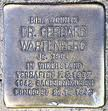A short biography of the German anarchist Gerhard Wartenberg, murdered by the Nazis.

Gerhard Wartenberg was born on 1st February 1904 at Tannroda in Thuringia, Germany into a Social-Democratic family. Although his parents were not wealthy they helped him get to Leipzig University where he studied chemistry, eventually getting a doctorate in 1928.
He joined the Anarcho-Syndicalist Youth (SAJD) at the age of eighteen. From 1926 he helped edit Der Bakunist (The Bakuninist) in Leipzig as well as contributing to Erich Muehsam’s magazine Fanal.
In 1927 he joined the FAUD. His first job was as a chemist at the Bergmann- Rosenthal cable works in Berlin but lost the job after disagreements with his managers. He then worked for a short time with the French firm Prophobia. He then worked at a factory manufacturing film in Moscow. This fixed term job of three years ended early in summer 1930 when Moscow withdrew the concession.
In Berlin the out of work Wartenberg engaged in intense political and journalistic activity. The same year he married Kate Pietzuch whom he had first met at an Easter 1928 meeting of the International Workers Association (IWA) in Leipzig. Their daughter Ilse was born the following year.
The pair had an interesting cultural life in Berlin and became good friends with Milly and Rudolf Rocker, visiting their home on many occasions. Wartenberg himself went on many speaking tours, many organized through the Corporation of Libertarian Booklovers. Often writing under the pen names of HW Gerhard and G.Berg he regularly contributed to the FAUD paper Der Syndikalist as well as issuing a series of small pamphlets.
His writings emphasized the need for an autonomous workers’ movement and he was an advocate of an organization that abolished the differences between economic and political organization. He was particularly hated by the Nazis for his pamphlet “From Hildburghausen to the Third Reich” under the name H. W. Gerhard. He described the true nature of Nazism and castigated the Communists and the Social Democrats for enabling the rise of the Nazis. The answer was working class unity from the grassroots, he posited. Unfortunately the FAUD was unable to bring this about. Their mass base of 150,000 had shrunk to a few thousand by the 1930s.
Wartenberg was editing Der Syndikalist from mid-1932, as well as from 1933 the newssheet Arbeiterecho and the theoretical magazine of the FAUD, Die Internationale. The Berlin FAUD responded slowly, unlike in other cities, to the Nazi seizure of power. Wartenberg was slow in finding a hiding place for the book stocks of the Libertarian Booklovers.
After a Gestapo search of the Berlin FAUD HQ, Wartenberg set up in other rooms, disguised as an an import-export company, from where he communicated with the FAUD nationally, sending out 100-150 letters a day reporting to FAUD locals on the situation in Berlin. In late April-early May he and Eduard Kopka went to Erfurt and arranged for direction of the underground FAUD organization to Emil Zehner. This task then passed to Ferdinand Gotze and then Richard Thiede.
In the meantime Wartenberg was sentenced in absentia to 2 months imprisonment for incitement to disobedience and transgression of the press law on 20th May 1933 This was as a result of articles in the Arbeiterecho calling for a general strike and all forms of direct action including sabotage, boycott and passive resistance. The paper was banned.
Wartenberg took refuge in Holland in April 1933 . He then moved to Leipzig where he worked with the family business, maintaining contact with FAUD militants and writing for the underground paper Der Socialistische Revolution.
It was not until early 1935 that Wartenberg was located by the police. He was arrested on 31st January. However the arrest warrant had expired and Wartenberg was released. Following the major repression of the German anarchist movement in 1937 Wartenberg was arrested on 7th May.
On 6th April 1938 he was sentenced to five years' imprisonment and deprivation of civil rights for high treason and he was also deprived of his doctorate. With the completion of his sentence Wartenberg was then promptly arrested by the Gestapo and in July 1942 sent to Sachsenhausen concentration camp.
On Christmas Eve 1942 Kate Wartenberg was summoned by the Gestapo. She was informed that on 22 December her husband had died of double pneumonia and she was given his ashes.
Sources:
Online article on Wartenberg by Hansi Oostinga
http://de.wikipedia.org/wiki/Gerhard_Wartenberg
Anarcho-syndicalism in Germany by Wartenberg
http://www.syndikalismusforschung.info/wart.htm
Wikipedia article:
http://de.wikipedia.org/wiki/Gerhard_Wartenberg




Comments
Thanks, Battlescarred, for
Thanks, Battlescarred, for information on yet another unsung comrade. Keep up the good work. On a purely pedantic note, the image is not actually a plaque but is a stolpersteine (stumbling block). These are set in the pavement outside the home of the person who was deported. Info on stolpersteines HERE.
Yes, you are totally right.
Yes, you are totally right.
there is also some stuff on
there is also some stuff on Wartenberg in Die "andere" Reichshauptstadt. Widerstand aus der Arbeiterbewegung in Berlin von 1933 - 1945 by Hans-Rainer Sandvoß (best study so far about working-class resistance in Berlin), will have a look if there are additional information
Wartenberg's anti-nazi
Wartenberg's anti-nazi pamphlet »Über Hildburghausen ins dritte Reich« (From Hildburghausen to the Third Reich) is now available online (in German)
https://muckracker.wordpress.com/2020/12/29/uber-hildburghausen-ins-dritte-reich-gerhard-wartenberg/
An extract from the pamphlet:
An extract from the pamphlet: Gerhard on National-Socialism https://www.katesharpleylibrary.net/1zcs69
better image of Soplerstein
better image of Soplerstein at: https://www.stolpersteine-berlin.de/en/biografie/1243 or https://de.wikipedia.org/wiki/Gerhard_Wartenberg